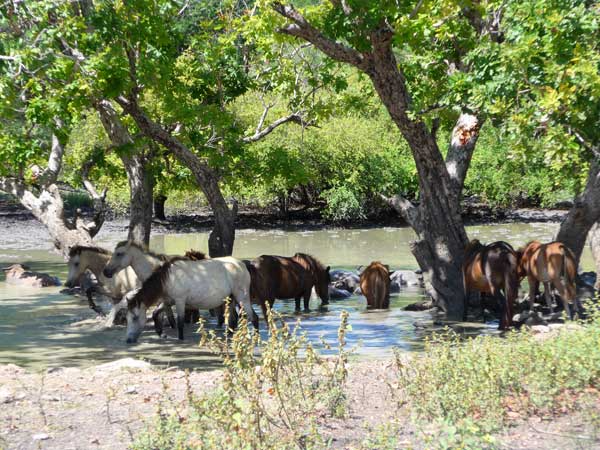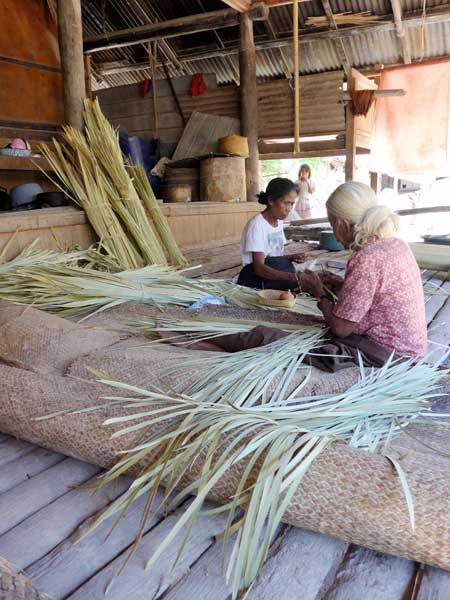Sumba – Reflections after 20 years

White Brahman cattle on Sumba highlands
The light in Sumba is like no other place. I am mesmerized as I drive along in the early hours of the morning how it highlights the contours of the low laying hills in the distance and outlines the stark white cattle grazing on this barren landscape.
The limestone that forms this land creates these strong contrasts and as the sun begins to climb in the sky the glare and heat off the land forces everything into the little shade that exists. Sunglasses are a must for us visitors and cataracts are common among the local people, being the least of the health problems that the people of east Sumba suffer.

Brilliant white limestone carved from the land for decorative gravestones

Horses are a common feature on the landscape in East Sumba
After twenty years of visiting Sumba several times a year the main road has improved, making our drive to Rindi a smooth two-hour ride rather than the jarring three to four hours of the past. Irrigation has created rice-growing areas well beyond the perimeter of the main city of Waingapu. Friends say they that they are now farming rather than weaving, and that homes are now being built of cement and breeze block rather than bamboo and wood. Certainly, not everyone enjoys these new advantages, but they demonstrate the economic benefits of water and the ability to grow crops almost year round now.
As we near Rindi we see a tall man with graying hair walking gracefully along the paths of his rice fields. We recognize Umbu Kanabu Ndaung and pull over, crossing the road to greet him. “We had a good rice crop,” Umbu declares proudly. Umbu is a dedicated farmer as well as the raja [king] of Rindi. He loves caring for his land and for the people he feels responsible for. We have known Umbu and his wife Tamu Rambu Eti since 1996 and enjoy spending time when either of we are in Sumba or they are in Bali.

Tamu Rambu Hamu Eti and Umbu Kanabu Ndaung with their five girl children in 2004

Re-weaving rice granaries
Umbu tells us that they are repairing the massive woven rice granary baskets made from the outer bark fiber of hua trees (Gnetum gnemon) that elsewhere in the archipelago are grown for their fruit from which melinjo crackers are made. The bark fiber is now hard to find so skilled women are re-weaving the damaged areas with lontar (Borassus flabellifer) palm fibers. “Five men holding hands can stand in the largest of these rice storage containers. We must have about twenty different sizes that we use,” says Umbu. We talk about the Parinna Uhu ceremony that traditionally took place after a harvest. The community all join in for song and ritual through the night as men take turns threshing the rice by stamping over it as they dance. This can go until early morning by which time the rice is all stored. “When Tamu Rambu Yuliana [Umbu’s elder sister and regent] was alive, we performed this ceremony at every harvest, so I remember all the stages and the words of the songs and prayers. Eti and I were thinking we need to perform this ceremony again so that the next generation can see and partake in it,” relates Umbu.
Arriving at the Uma Penji, where Umbu and Eti live with forty other people of the household, we are offered betel nut and served coffee. Umbu often divides up land for his retainers and helps finance them to buy cattle or seed. The sound of children has been a constant at Uma Penji since I can remember with babies being passed from one woman to another. Eti and Umbu’s own five daughters are now grown, having graduated from University, and the oldest three are engaged to being married.

Umbu and Eti on their front porch discussing weaving equipment

Traditional ceremony in the Uma Penji house
Who will be the heir to Rindi is a concern for Umbu and Eti as they only have daughters who, when they marry, will move to other communities. At first the couple hoped they could adopt a grandchild from the marriage of their eldest daughter and a man from the royal family in Prailiu, but the ritual politics of this sound difficult. They are now thinking of how to adopt a child from within their own clan. “It’ll work out,” Eti laughs. “We believe that we will always be given what we need if we remember to call on our ancestors for support and guidance. People tell us we are backwards because we worship rocks. We don’t worship rocks per se, I tell them, but rather the rock or tree creates a means or medium by which we can focus our connection to the Divine, which we call Marapu. We have ceremonies to focus our thoughts and intentions so that we live as caring human beings; caring for each other, for the plants that we use for food or building materials, and for the animals that we will use for food and as sacrifice for life cycle ceremonies.”
Eti talked about the importance of believing that we will be helped with whatever we set out to do. “Positive thinking,” she chuckles, “but this is how we have been taught by our parents and grandparents: always know that if we have a clear intention and stay true that our path will be smooth, like the walamangata motif on the textiles reminds us.” Liti tana linjak / Apa ai mambuanahu, goes the couplet associated with the motif: standing on level ground / holding a tree with no branches. The saying means, if you fulfill your promises without deviation, the road will be smooth for you.

Dai Manggil holds a textile with the floral Walamangata image (right) among animal patterns

In a field of rice not yet harvested, small white plastic bags that were hung to scare birds look like tiny lanterns aglow
We had meant to only stay a few hours but it was now almost 5 pm and the heat was out of the day. We had been sitting and talking for more than five hours! I felt humbled by our discussion, my friends’ words so wise and true! As we left, the sky was turning a bright reddish-gold. When we passed Umbu’s land where the rice had just been harvested, high clouds were reflected in the still water that lay across the fields.
The next day we headed north to one of the communities we work with. We found a grim reminder that all is not light and easy in Sumba. Dai Manggil held her newborn baby who was screaming to nurse, but after each nursing he would curl up in a ball and wail again, clearly in pain. “I brought him to the doctor, he said there is nothing to do.” The pigs snuffled for food under our feet; the bench we sat on was covered in chicken droppings. She offered us boiled peanuts that they had just harvested and told us that she could not weave or dye as her baby cried all the time. Her other son, now four does not talk or move; he is in the hospital now and is likely to die. I held the baby – clearly having fits of colic – praying he would outgrow this and wishing there was more we could do other than order textiles. “I will have my ‘niece’ next door to help me so I can weave,” Dail Manggil promised but her face still looked worried.

Textiles having been dyed and ready to be warped onto a loom

Sumba from the air: lost in the glare
As we lift off away from the island of Sumba the next day, heading back to Bali, I think of the two worlds that I have just spent time in. Through Eti’s eyes, one of these worlds is perceived as being full of faith and promise. The other is a world of despair, trapped in the downward spiral of poverty, that Dai Manggil experiences. The plane’s silver body catches the light and I am lost in the glare, unable to see the land anymore. The contrasts and contradictions leave me confused and groundless, unable to find resolution. But then, perhaps the resolution is in remaining, open hearted, in the questions.

